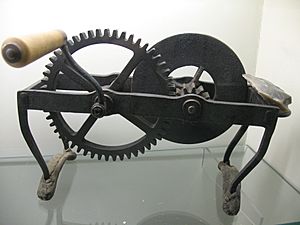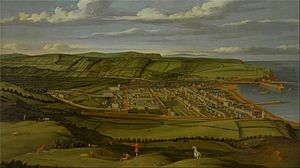Sir James Lowther, 4th Baronet facts for kids
Sir James Lowther, 4th Baronet (1673 – 1755) was a very rich English landowner and industrialist. He was also a Whig politician who served in the House of Commons for 54 years! He owned and developed many coal mines near Whitehaven in Cumberland, which made him incredibly wealthy. People said he was the richest commoner (someone without a noble title) in England.
Contents
Early Life and Family Wealth
James Lowther was born in London in 1673. He studied at Queen's College, Oxford and became a lawyer. When his father died in 1706, James's older brother, Christopher, inherited the family title. However, because Christopher had made some unwise choices, most of the family's valuable properties, including the coal mines, went to James. James later inherited the baronetcy (a type of noble title) himself in 1731 when his brother passed away without children.
Political Career
In 1694, James Lowther became a Member of Parliament for Carlisle. He held this seat until 1702. He also worked for the Board of Ordnance, which managed military supplies. In 1708, he returned to Parliament, representing Cumberland. He held this seat for many years, almost continuously until his death.
He was elected to Parliament 15 times and served for 60 years! He was the only Member of Parliament from the previous session who had also served during the time of King William. In 1714, he became a Privy Counsellor, a high-ranking advisor to the King. Even though he was a Whig, he wasn't very interested in national politics. His main goal in Parliament was to help his local area in Cumbria.
How Sir James Lowther Became Rich
Sir James Lowther's main source of wealth came from his coal mines in West Cumberland. When he took over, these mines were exporting about 35,000 tons of coal a year and making a profit of about £1,000 annually. He used this money to buy more land and improve his mines, becoming the most powerful coal owner in the area.
Most of the coal from Whitehaven was sold to Ireland. Unlike other coal owners who formed groups to control prices, Lowther used different strategies to stay on top. He was known for choosing very skilled people to manage his mines, especially the Spedding brothers. He kept in close contact with them through letters and visited Whitehaven most summers. Under his leadership, the coal output from his Whitehaven mines more than tripled, and their profits grew six times larger!
The Spedding Brothers: Mining Experts
John Spedding (1685–1758) started working for Lowther's father. He helped with the accounts and later became the colliery manager after some dishonest management was discovered.
John's younger brother, Carlisle Spedding, became a famous mining engineer. He introduced many new ideas in the Lowther mines at Whitehaven. He later took over as colliery manager from his brother in 1730.
Expanding His Coal Empire
Between 1709 and 1754, Sir James Lowther spent over £46,000 to buy more land and coal rights in West Cumberland. His goal was to eliminate his local competitors and create a monopoly (where he would be the only seller). He didn't quite achieve a full monopoly, but by the 1740s, he was the main coal exporter from every harbor in the coalfield.
He even lent money to local landowners, hoping they couldn't pay it back so he could take over their properties. He bought out mine owners in Moresby and Distington. He also managed to lease the Seaton colliery in 1731, which his manager, Spedding, saw as the biggest challenge to Lowther's control of the coalfield.
He also got a lease for coal rights from St Bees School in 1742 under very unfair terms. This lease was later cancelled in 1827, and his family had to pay back over £13,000 in royalties.
Mining Innovations and Improvements
Draining Mines with Steam Pumps
The coal seams in Lowther's Whitehaven mines went deep underground, making it hard to keep them from flooding. At first, horses were used to pump water out, but this was very expensive.
In 1712, John Spedding suggested using Captain Savery's steam-powered pumps. In 1715, Lowther talked to Thomas Newcomen, who invented the Newcomen engine. Spedding found Newcomen's ideas very good, estimating that a Newcomen engine could clear a flooded pit much faster and cheaper than horses.
A contract was signed in 1715 for a small Newcomen engine. Even with some initial problems, the engine worked well. After ten years, Lowther bought the engine and the right to use it. He even bought a license to build another, slightly larger one. Lowther was very impressed with Newcomen, calling him "a very honest good man."
Mining Coal Under the Sea: Saltom Pit
With the help of steam pumps, Lowther could now mine coal deeper and closer to the sea. In 1730, work began on Saltom pit, located near the seashore. It officially opened in May 1732 with big celebrations!
The Newcastle Courant newspaper praised the project, calling it "generous and great." The shaft was sunk 77 fathoms (about 462 feet), making it the deepest pit in Europe at the time. This was done in just 23 months, using a lot of gunpowder, and without any serious accidents. They even dealt with a dangerous gas pocket (a "blower" of firedamp) at 42 fathoms. The newspaper gave credit to Sir James Lowther's managers, John and Carlisle Spedding, for their "unparallel'd Conduct and Skill." This amazing project meant that a valuable coal mine would be available for "many Generations."
Even with these successes, more improvements were needed. The pumping engine at Saltom wasn't strong enough, so two larger ones were installed by 1739. Saltom pit allowed mining of coal that was impossible to reach before. By 1765, the mine extended a mile and a half from the shaft and three-quarters of a mile out under the sea!
Dealing with Dangerous Mine Gas (Firedamp)
When sinking Saltom pit, they hit a large pocket of firedamp, a dangerous gas. Lowther described this to the Royal Society and asked for ideas on how to deal with it. When lit with a candle, the gas created a steady flame, about half a yard wide and nearly two yards high! They managed to put out the flame and seal off the gas, piping it to the surface. Even two and a half years later, the gas was still flowing strongly.
The Royal Society made Sir James a Fellow, but they couldn't find a better solution than what Carlisle Spedding had already figured out: firedamp only ignited with a flame, not sparks. Because of this, miners often used flint and steel to create a dim light in gassy areas.
Spedding invented a "steel mill," a device where a flint was held against a fast-spinning steel disc, making sparks for light. Another worker had to operate it. This "steel mill" was a safer alternative to open flames and was used in other coalfields before the Davy lamp was invented.
Spedding also improved mine ventilation by "coursing the air." Fresh air was drawn into the mine through one part of a shaft. It then flowed through the working areas and was routed through older parts of the mine to prevent gas from building up. This method also became standard practice in other coalfields.
Improving Harbors for Coal Export
Sir James's father had already developed Whitehaven as a port for exporting coal. James continued this work. In 1709, James got a special law passed to improve Whitehaven harbor and collect tolls (fees) on coal cargoes and ships to pay for the upgrades.
The harbor was managed by a committee of trustees, with seven chosen by Lowther himself. During his lifetime, the harbor was made deeper, and a new outer harbor was built, greatly increasing its capacity.
Transporting coal to the harbor was also improved. They introduced "waggonways" (early railways) and a new "staith" at the harbor. This staith had five "hurries" or spouts, allowing several ships to be loaded at once. Coal wagons would arrive, open their bottoms, and the coal would drop through the spouts directly into the ships. This made loading much faster and more efficient.
Lowther also gained control of Parton harbor, another port nearby, by buying out the interests of other owners. This made Parton a Lowther harbor too, though it was less important than Whitehaven.
Life and Legacy
Wealth and Simple Lifestyle
By the 1730s, Sir James Lowther was known as the richest commoner in England, with an income of about £25,000 a year when he died. He helped fund two new churches in Whitehaven and was a governor of important hospitals.
Despite his huge wealth, he lived a very simple life. This earned him the nickname "Farthing Jemmy" because he was known for being very careful with money, even small amounts. Some stories say he would return a bad halfpenny to a coffee house even though he had a massive fortune.
Health and Later Life
Like his father, Lowther suffered from gout, a painful joint condition. From 1726 onwards, he had severe attacks almost every winter. In 1750, at 77 years old, he had a very bad attack that led to the amputation of his right leg. He survived the surgery and continued his routine of spending most of the year in London, managing his mines through letters, and summers in Whitehaven. He passed away in London in January 1755 and was buried in Holy Trinity church in Whitehaven, which he had helped establish.
His Will and Legacy
Before his death, a religious leader named John Wesley wrote to Lowther, encouraging him to be more generous with his money and to leave his wealth to good causes rather than just his family. Wesley questioned whether Lowther would be happy about the money he left behind, especially if it supported a "fancy lifestyle" that Lowther himself had avoided.
Despite Wesley's advice, Lowther mostly divided his vast fortune among other Lowther baronets, who were distant relatives. He did leave £1,000 to John Spedding and £500 to Carlisle Spedding, his loyal managers. His estates in Cumberland, including the very profitable coal mines, went to Sir William Lowther. His other properties and investments went to Sir James Lowther of Lowther.
Sir William died in 1756, and his inherited properties then passed to Sir James Lowther of Lowther, who was sometimes called "Wicked Jimmy."
Images for kids







